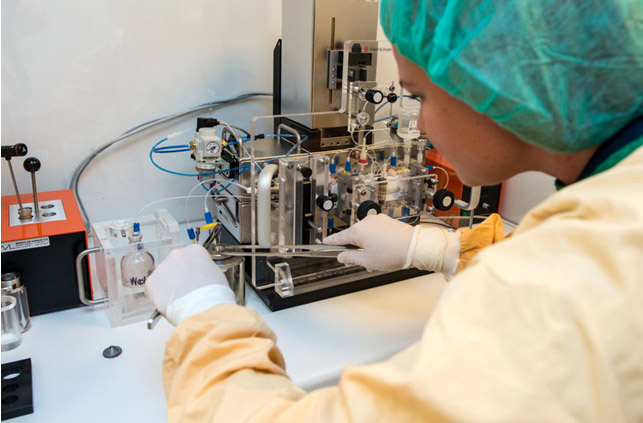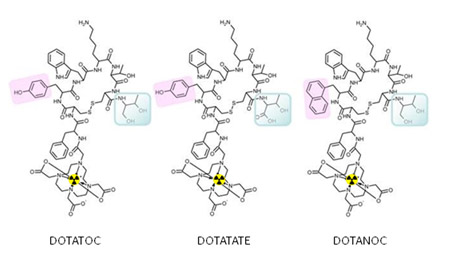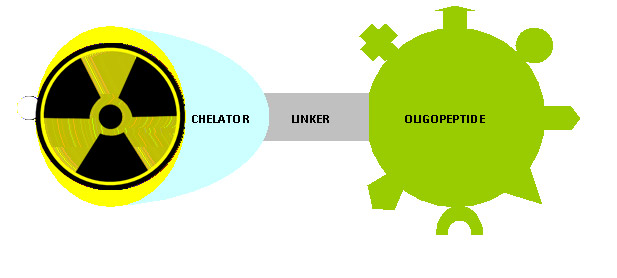Anders Floor Frelsen & Marie Louise Olesen, April 2016
Internal radiotherapy at Department of Nuclear Medicine

The Department of Nuclear Medicine (NUK) and PET- Centre is part of Aarhus University Hospital ENETS Center of Excellence.
As a third or fourth line treatment, neuroendocrine tumours (NETs) are treated with β-emitting radioisotopes. This is a targeted treatment, a so-called peptide receptor radiotherapy (PRRT). NETs commonly overexpress somatostatin receptors (sstr), in particular subtype 2 (sstr2). Somatostatin is a naturally occurring oligopeptide that, among other effects, inhibits tumour cell growth. Stabilised somatostatin analogues are synthetic peptides designed to interact with sstrs. This ability is leveraged in PRRT, where a radionuclide is attached to the somatostatin analogue and thus delivered to the tumour where it delivers cytotoxic radiation.

The most commonly used somatostatin analogues for PRRT are the 1,4,7,10-tetraazacyclododecane-1,4,7,10-tetraacetic acid (DOTA) functionalised octreotide derivatives DOTA-[Tyr3,Thr8]-octreotide (DOTATATE), DOTA-[Tyr3]-octreotide (DOTATOC) and DOTA-[Nal3]-octreotide (DOTANOC). They all target sstrs but they each have different preferences among the sstr subtypes. These structures are all constructed with a chelator, a linker and an oligopeptide. The radioisotope is bound to the chelator, and the chelator is bound to the oligopeptide through a suitable linker.

NUK has several years of experience working with Y-90 radiolabelling of DOTA-peptides for PRRT. Y-90 is a pure β-emitting isotope with a half-life of 64 h. The maximum range of Y-90 β-particle penetration in soft tissue is 11 mm, while the average range of the Y-90 β-particles is 3.9 mm.
Recently we have added the radioisotope Lu-177 to our repertoire. In comparison to Y-90 the range of β-particle penetration in soft tissue is smaller. The maximum depth of β-particle penetration is 1.7 mm, while the average β-particle penetration is 0.23 mm. Due to the shorter range of the β-emissions, the undesired effect on healthy tissue is reduced when treating with Lu-177. However, in larger, more heterogeneous tumours the longer range of Y-90 is advantageous. Lu-177 also has γ-emissions at 113 keV and 208 keV. These γ-emission lines allow imaging and dosimetry after treatment.
We are constantly evolving synthesis procedures to take advantage of new technology and limit radiation exposure to our staff. We have previously developed methods for manually radiolabelling DOTA-peptides with Y-90. Recently we have acquired a Modular-Lab PharmTracer system, which allows automated radiolabelling of chelator linked-peptides with different radioisotopes. This system is currently being implemented in our routine productions.
We are currently bringing new radioisotopes into use. This involves establishing procedures for measuring and shielding radioisotopes with different emission patterns as well as handling radioactive waste with different half-lives. Development of radiolabelling conditions and applying for new permissions is constantly a part of the work with both new and well established methods and radioisotopes. Latest α-emitters have received a lot of attention as therapeutic isotopes.